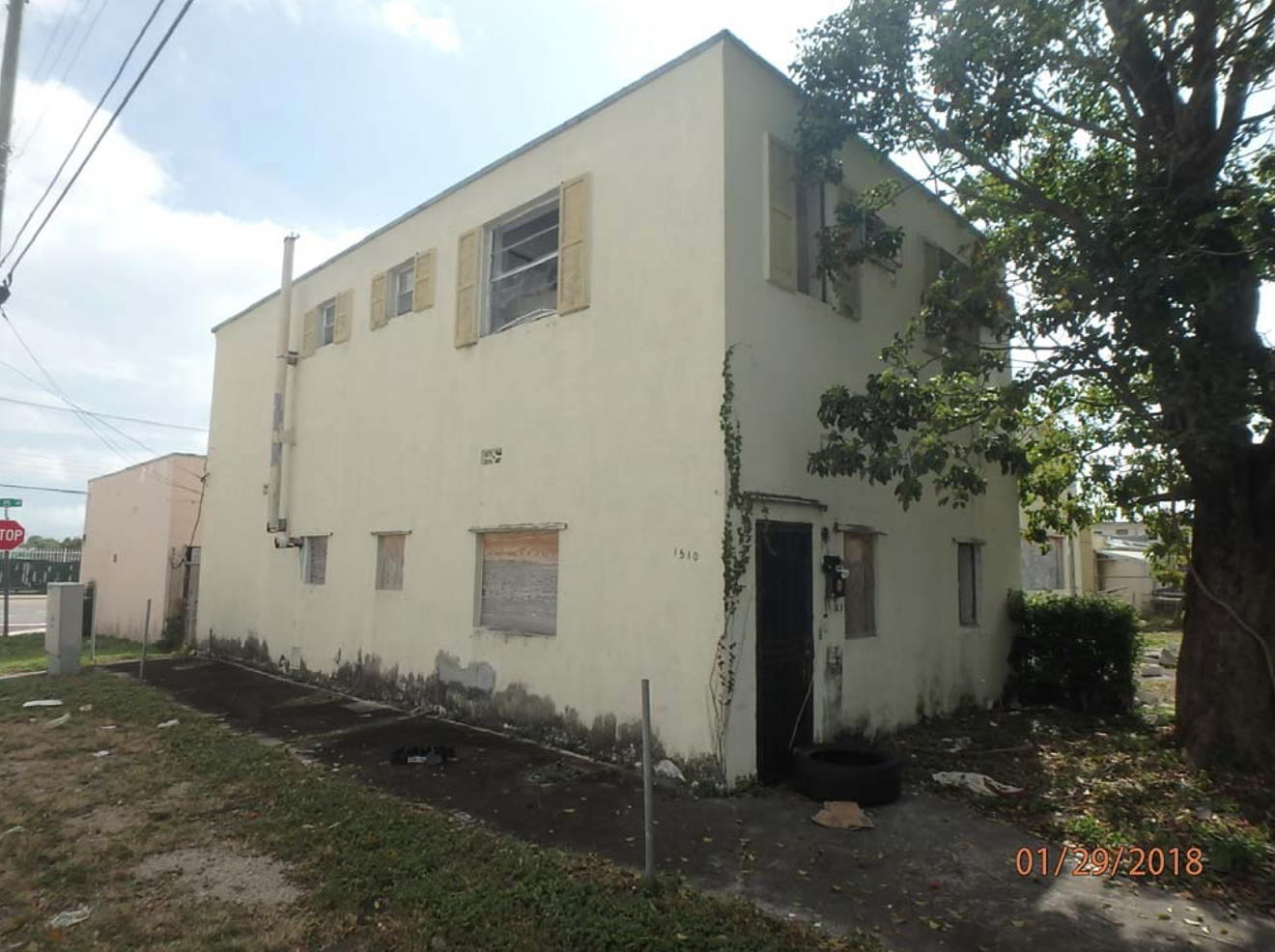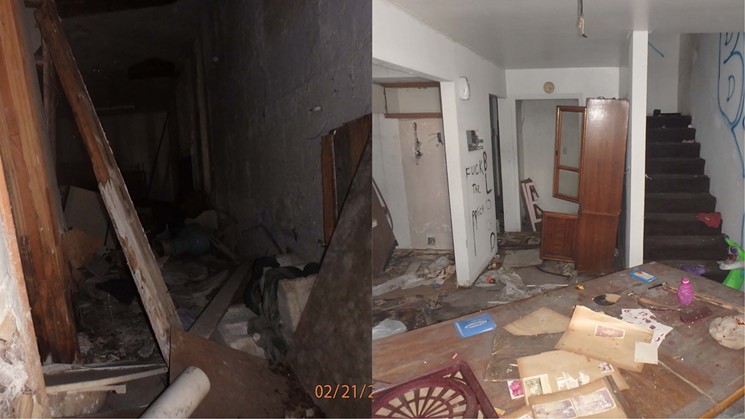Studies clearly show dilapidated houses depress property values and spread pollution and toxins such as lead. But so-called anti-blight programs can also exacerbate gentrification, and now family members who have owned a home in Liberty City since the 1940s claim the City of Miami is railroading them out of their property despite the fact they've already spent thousands cleaning the place and have made formal plans to spend much more fixing up the home.
Those homeowners say their story raises serious questions about whether the city's blight-fighting initiatives have the best interests of longtime residents in mind.
"Do we have to hire a lawyer now just so we can save a home that belongs to us?" Leslie Patterson-Tyler says. "That's expensive, and we're trying to use that money to rehab the house and turn it into something good for the community."
City of Miami spokesperson Eugene Ramirez confirmed yesterday that the city is trying to bulldoze the property under the Safe City program, although he stressed that the city began citing Patterson-Tyler's property before the program began. But despite the PR fanfare about Safe City, Ramirez denied the city is encouraging building inspectors to rapidly condemn homes. He said the building department is simply convinced that Patterson-Tyler's property is dangerous and damaged beyond repair.
"We don’t go around knocking down houses because of this new initiative," Ramirez said. "We knock down houses because this is a safe thing to do.
Patterson-Tyler and her 75-year-old mother, Sharon Patterson, tell New Times that the home on NW 66th Street was purchased by Leslie's great-grandfather, Dr. William A. Patterson Sr., roughly 70 years ago. Leslie lived in the home at various points when they grew up, as did her father, Dr. William A. Patterson Jr. Sharon now lives in Pembroke Pines, and Leslie, a former news producer for NBC 6 Miami, lives in Philadelphia.
About a decade ago, the Pattersons agreed to turn the home into a rental property for low-income tenants. They say some extended family members mismanaged the house and let it fall into decay. They admit that by mid-2017, squatters were moving in and out of the property. Photos show the home's windows were broken,
According to city records, someone filed a complaint about the Pattersons' property in April 2017. After the city investigated, the building department sent notices to the family that month and July ordering them to clean up the house. But the elder Patterson says she didn't receive any warnings about the property until months after the initial notices were sent; records show the notices were mailed to one of the family's other residences in Ohio. A city spokesperson placed the blame for the missed notices on the Pattersons for not updating their official mailing address on their property records.
The Pattersons say that once they finally received an official warning about the home, they tried to get the place back in working order: Sharon says she called the Miami Police Department to alert them that the home was unoccupied and asked for help kicking squatters off the property.
"I was trying to call the police, but nobody helped," she says.
This past January 30, the city sent the Pattersons a notice that their home was slated for demolition. Records show the city sent that letter to Ohio. When the family finally received that notice, they learned the city had set a public hearing March 23 where the family could show the building department that it was working to fix the home.
That's exactly what the Pattersons say they tried to do. They
Sharon traveled from Pembroke Pines to attend the public meeting last Friday. She said she brought photographs of the cleaned-up home as well as documentation showing the family had hired contractors and an engineer. But the family says the Unsafe Structures Board, led by department chief Rene Diaz, spoke down to her, asked if she was hard of hearing, and refused to review the documents she brought.
"Nobody on that board looked like me," Sharon Patterson tells New Times in reference to the fact that she's a black woman. "Diaz just said, 'We agree with the city's recommendation to demolish the property.' He didn't look at anything we brought."
Moreover, the family says city officials have never provided any evidence of structural problems. After the meeting last week, Leslie Patterson-Tyler sent Assistant City Attorney Rachel Dooley an email demanding the city reconsider its position:
At today's hearing, Ms. Dooley, my mom felt bullied and we believe we are being forced out of our home, and that the city is trying to steal and destroy our property. My mom took time out of her schedule to appear before the Board on the date requested and, despite her presence, the Board disrespected her and refused to listen to her. The Board also failed to review documents and updated photos she brought to the hearing. While we appreciate your forwarding the information to her today, you should know this is the first time we've seen the complete report despite multiple requests to have it mailed to us.
Here are our concerns:
* The three unsafe dwelling notices sent in January, February, and March of 2018, were all mailed to my mom's seasonal home in Ohio [address redacted]. The notices were never forwarded to her current home address in Florida and none of the property owners received these letters
* The photographs you sent have a date stamp of January 29, 2018, and do not reflect the current condition of the home. Since February 20, 2018, the doors and windows have all been secured, and both the exterior and interior of the dwelling have been completely cleaned out.
* We have a signed agreement with an engineer to inspect the home and begin the restoration process My mom, Sharon Patterson, brought this document to the hearing today and the Board refused to look at it, did not make copies, and never considered it when making their arbitrary decision to demolish the property.
Dooley replied in three sentences: "As your Mother was informed, there are serious issues with the property. It has become a tremendous hardship for the people who have to live next to the deteriorated condition in which it exists today. Having said that, if anyone has plans ready for the City’s review, please bring
For now, the city says the Pattersons have been ordered to demolish the building (at their own cost) within 30 days. If the family does not do so, a city spokesperson said
"Early in
But the Pattersons say they cleaned the place up before their March 23 hearing and can't understand why the city believes this is such an open-and-shut case. Their last resort might be to take the fight to court — something they don't want to do because they'd rather spend that money on fixing the home.
"We're trying to rehab the house and save it," Leslie Patterson-Tyler says. "My great-grandfather William Patterson Sr. was a pharmacist in Overtown. My grandfather William A. Patterson Jr. was a physician. Maybe we can rehab the property and turn it into
The Pattersons' case shines a spotlight on the city's initiative to demolish unsafe structures. Studies show that anti-vacancy programs help raise property values and make local neighborhoods greener. Baltimore's Vacants to Value and Detroit's massive land-bank initiative, for example, have been held up as national models for ways to deal with dilapidated homes and derelict, absentee homeowners.
But questions remain about whom the blight-fighting programs actually benefit: So-called urban renewal programs in the 1940s through 1960s were barely hidden attempts at purging black and brown people from neighborhoods before wealthier white folks moved in to claim the land. In 1964, author James Baldwin famously noted that urban renewal "means Negro removal."
In the 1980s and 1990s, politicians and police departments propagated the now-debunked "broken windows theory," which held that dilapidated homes, petty lawlessness, and graffiti-covered walls psychologically encourage people to commit more serious crimes. That mindset led to decades of severely harsh punishment for poor, black residents caught skipping subway turnstiles or selling loose cigarettes — but did not reduce crime.
There are still some good arguments for taking over or demolishing some decrepit properties (especially ones run by absentee slumlords), but experts say cities shouldn't simply plow over poor neighborhoods and then hand the land off to real-estate moguls. In Saginaw, Michigan, a former CBS TV executive used his fortune to turn a former group of derelict Section 8 low-income homes seized by the city into fancy apartments. The Vacants to Value program in Baltimore has also angered community activists, who note that some of the demolished lots across the city are then sold to for-profit land developers who are under no obligation to build low-income homes. A 2015 report from Baltimore's Abell Foundation, which tracks quality-of-life issues in that city, noted that Vacants to Value "does not address the city’s affordable-housing crisis."
Miami's well-publicized demolition in Little Havana earlier this month — the tenth blighted-home demolition of the year — was couched in a scaremongering speech by City Commissioner Joe Carollo, the ex-mayor who resurrected his career in 2017 despite past allegations of spousal abuse. Carollo suggested "graffiti culture" was linked to drug crime.
"The same graffiti that you see inside that building," he said at the March 15 demolition, pointing to the house behind him, "I dare you to walk through some of the streets on Calle Ocho. You see some of the newcomers that all of a sudden claim they created Little Havana, Calle Ocho, that are buying up properties. You see the same type of graffiti that they invite these people to paint on their walls. In the last month and a half or so, we've been making arrests for drugs and other crimes in Little Havana like you haven't seen in years."
Sharon Patterson tells New Times she worries that well-connected developers are pressuring city officials to help them purchase land in poor neighborhoods — especially Liberty City, which sits higher above sea level than most other areas of Miami. Land in the neighborhood is expected to become more expensive as the oceans rise, and the Pattersons say they have already been approached by real-estate buyers offering to buy them out on the spot — a practice that fair-housing advocates have previously told New Times is common in the rapidly gentrifying Little Haiti.
At the county level, Mayor Carlos Gimenez has pushed through a controversial plan to demolish the low-income-housing community Liberty Square (immortalized in the Best Picture-winning film Moonlight) and replace the homes with a mix of low-income apartments and so-called market-rate rentals. Fair-housing advocates and longtime Liberty City residents have blasted the plan as a gift to property developers disguised as an anti-poverty initiative, but other residents say they would enjoy living in new apartments with shops nearby, provided prices remain affordable.













